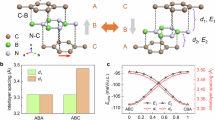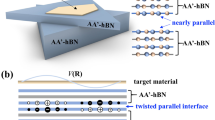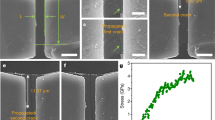Abstract
Van der Waals (vdW) materials consisting of two-dimensional (2D) building blocks have strong in-plane covalent bonding and weak interlayer interactions. While monolayer 2D materials exhibit impressive fracture resistance, as demonstrated in hexagonal boron nitride (h-BN), preserving these remarkable properties in vdW materials remains a challenge. Here we reveal an anomalous mechanical interlayer coupling that involves interlayer-friction toughening and edge-reconstruction embrittlement during the fracture of multilayer h-BN. Both asynchronous and synchronous fracture modes and their flaw-size dependence are identified. Edge reconstruction in the synchronous fracture mode can eliminate a toughening mechanism induced by lattice asymmetry in monolayer h-BN, leading to embrittlement of the multilayer h-BN, while the asynchronous fracture mode results in greater fracture resistance. Such findings will provide fundamental guidelines for engineering interlayer interactions in vdW materials including heterostructures and layered architectures for better mechanical and functional performances.
This is a preview of subscription content, access via your institution
Access options
Access Nature and 54 other Nature Portfolio journals
Get Nature+, our best-value online-access subscription
$32.99 / 30 days
cancel any time
Subscribe to this journal
Receive 12 print issues and online access
$259.00 per year
only $21.58 per issue
Buy this article
- Purchase on SpringerLink
- Instant access to full article PDF
Prices may be subject to local taxes which are calculated during checkout




Similar content being viewed by others
Data availability
The data that support the findings of this study are available from the corresponding authors on reasonable request.
Code availability
The code that supports the findings of this study is available from the corresponding authors on reasonable request.
References
Cao, Y. et al. Unconventional superconductivity in magic-angle graphene superlattices. Nature 556, 43–50 (2018).
Liu, Z. et al. Observation of microscale superlubricity in graphite. Phys. Rev. Lett. 108, 205503 (2012).
Liao, M. et al. UItra-low friction and edge-pinning effect in large-lattice-mismatch van der Waals heterostructures. Nat. Mater. 21, 47–53 (2022).
Song, Y. et al. Robust microscale superlubricity in graphite/hexagonal boron nitride layered heterojunctions. Nat. Mater. 17, 894–899 (2018).
Jin, C. et al. Observation of moiré excitons in WSe2/WS2 heterostructure superlattices. Nature 567, 76–80 (2019).
Shinokita, K., Miyauchi, Y., Watanabe, K., Taniguchi, T. & Matsuda, K. Resonant coupling of a moiré exciton to a phonon in a WSe2/MoSe2 heterobilayer. Nano Lett. 21, 5938–5944 (2021).
Nakamura, K. et al. All 2D heterostructure tunnel field-effect transistors: impact of band alignment and heterointerface quality. ACS Appl. Mater. Interfaces 12, 51598–51606 (2020).
Sukma Aji, A. et al. Two-step synthesis and characterization of vertically stacked SnS–WS2 and SnS–MoS2 p–n heterojunctions. Phys. Chem. Chem. Phys. 20, 889–897 (2018).
Park, J. M. et al. Robust superconductivity in magic-angle multilayer graphene family. Nat. Mater. 21, 877–883 (2022).
Ribeiro-Palau, R. et al. Twistable electronics with dynamically rotatable heterostructures. Science 361, 690–693 (2018).
Kapfer, M. et al. Programming twist angle and strain profiles in 2D materials. Science 381, 677–681 (2023).
Lee, C., Wei, X., Kysar, J. W. & Hone, J. Measurement of the elastic properties and intrinsic strength of monolayer graphene. Science 321, 385–388 (2008).
Yang, Y. et al. Intrinsic toughening and stable crack propagation in hexagonal boron nitride. Nature 594, 57–61 (2021).
Jang, B. et al. Asynchronous cracking with dissimilar paths in multilayer graphene. Nanoscale 9, 17325–17333 (2017).
Jung, G. S. et al. Interlocking friction governs the mechanical fracture of bilayer MoS2. ACS Nano 12, 3600–3608 (2018).
Zhang, P. et al. Fracture toughness of graphene. Nat. Commun. 5, 3782 (2014).
Constantinescu, G., Kuc, A. & Heine, T. Stacking in bulk and bilayer hexagonal boron nitride. Phys. Rev. Lett. 111, 036104 (2013).
Falin, A. et al. Mechanical properties of atomically thin boron nitride and the role of interlayer interactions. Nat. Commun. 8, 15815 (2017).
Wei, X. et al. Comparative fracture toughness of multilayer graphenes and boronitrenes. Nano Lett. 15, 689–694 (2015).
Aksay, I. A. et al. Biomimetic pathways for assembling inorganic thin films. Science 273, 892–898 (1996).
Finnemore, A. et al. Biomimetic layer-by-layer assembly of artificial nacre. Nat. Commun. 3, 966 (2012).
Wu, X. et al. Heterogeneous lamella structure unites ultrafine-grain strength with coarse-grain ductility. Proc. Natl Acad. Sci. USA 112, 14501–14505 (2015).
Wegst, U. G. K., Bai, H., Saiz, E., Tomsia, A. P. & Ritchie, R. O. Bioinspired structural materials. Nat. Mater. 14, 23–36 (2015).
Gao, H. & Chen, S. Flaw tolerance in a thin strip under tension. J. Appl. Mech. 72, 732–737 (2005).
Griffith, A. A. VI. The phenomena of rupture and flow in solids. Philos. Trans. R. Soc. A 221, 163–198 (1921).
Buehler, M. J. & Gao, H. Dynamical fracture instabilities due to local hyperelasticity at crack tips. Nature 439, 307–310 (2006).
Buehler, M. J., Abraham, F. F. & Gao, H. Hyperelasticity governs dynamic fracture at a critical length scale. Nature 426, 141–146 (2003).
Liu, Z., Suenaga, K., Harris, P. J. F. & Iijima, S. Open and closed edges of graphene layers. Phys. Rev. Lett. 102, 015501 (2009).
Alem, N. et al. Subangstrom edge relaxations probed by electron microscopy in hexagonal boron nitride. Phys. Rev. Lett. 109, 205502 (2012).
Thomson, R., Hsieh, C. & Rana, V. Lattice trapping of fracture cracks. J. Appl. Phys. 42, 3154–3160 (1971).
Weertman, J. Dislocation Based Fracture Mechanics (World Scientific, 1996).
Li, X., Wei, Y., Lu, L., Lu, K. & Gao, H. Dislocation nucleation governed softening and maximum strength in nano-twinned metals. Nature 464, 877–880 (2010).
Caillard, D. & Martin, J. Thermally Activated Mechanisms in Crystal Plasticity (Pergamon, 2003).
Sheppard, D., Xiao, P., Chemelewski, W., Johnson, D. D. & Henkelman, G. A generalized solid-state nudged elastic band method. J. Chem. Phys. 136, 074103 (2012).
Ago, H. et al. Science of 2.5 dimensional materials: paradigm shift of materials science toward future social innovation. Sci. Technol. Adv. Mater. 23, 275–299 (2022).
Park, J. M., Cao, Y., Watanabe, K., Taniguchi, T. & Jarillo-Herrero, P. Tunable strongly coupled superconductivity in magic-angle twisted trilayer graphene. Nature 590, 249–255 (2021).
Hod, O., Meyer, E., Zheng, Q. & Urbakh, M. Structural superlubricity and ultralow friction across the length scales. Nature 563, 485–492 (2018).
Liu, K. et al. Evolution of interlayer coupling in twisted molybdenum disulfide bilayers. Nat. Commun. 5, 4966 (2014).
Koch, C. T. Determination of Core Structure Periodicity and Point Defect Density Along Dislocations. PhD thesis, Arizona State Univ. (2002).
Kresse, G. & Furthmuller, J. Efficiency of ab-initio total energy calculations for metals and semiconductors using a plane-wave basis set. Comput. Mater. Sci. 6, 15–50 (1996).
Kresse, G. & Furthmuller, J. Efficient iterative schemes for ab initio total-energy calculations using a plane-wave basis set. Phys. Rev. B 54, 11169–11186 (1996).
Kresse, G. & Joubert, D. From ultrasoft pseudopotentials to the projector augmented-wave method. Phys. Rev. B 59, 1758–1775 (1999).
Perdew, J. P., Burke, K. & Ernzerhof, M. Generalized gradient approximation made simple. Phys. Rev. Lett. 77, 3865–3868 (1996).
Kim, S. M. et al. Synthesis of large-area multilayer hexagonal boron nitride for high material performance. Nat. Commun. 6, 8662 (2015).
Pease, R. S. An X-ray study of boron nitride. Acta Crystallogr. 5, 356–361 (1952).
Henkelman, G., Uberuaga, B. P. & Jónsson, H. A climbing image nudged elastic band method for finding saddle points and minimum energy paths. J. Chem. Phys. 113, 9901–9904 (2000).
Henkelman, G. & Jónsson, H. Improved tangent estimate in the nudged elastic band method for finding minimum energy paths and saddle points. J. Chem. Phys. 113, 9978–9985 (2000).
Acknowledgements
We acknowledge the financial support by the US Department of Energy, Office of Basic Energy Sciences under grant DE-SC0018193. H.G. acknowledges a start-up grant from Nanyang Technological University (002479-00001) and Agency for Science, Technology and Research (A*STAR). During the revision of this manuscript, the affiliation of H.G. has changed to Mechano-X Institute, Applied Mechanics Laboratory, Department of Engineering Mechanics, Tsinghua University, Beijing, China.
Author information
Authors and Affiliations
Contributions
Z.S., B.Z. and Y.Y. conceived the project. B.Z., Y.Y. and J.L. designed the experiments and analysed the data. Z.S. and H.G. performed simulations and analysed the results. G.G., Y.H. and D.T. performed TEM analysis. Q.F., B.S., D.S., Q.A. and X.Z. helped with the sample preparation and characterization. Y.Z. performed digital image correlation. T.T. and K.W. performed material synthesis. Z.S., B.Z., Y.Y. supervised by N.P.P., B.W.S., J.L. and H.G. drafted the manuscript with inputs, discussion and approval from all co-authors.
Corresponding authors
Ethics declarations
Competing interests
The authors declare no competing interests.
Peer review
Peer review information
Nature Materials thanks Zonghoon Lee, Arend van der Zande and the other, anonymous, reviewer(s) for their contribution to the peer review of this work.
Additional information
Publisher’s note Springer Nature remains neutral with regard to jurisdictional claims in published maps and institutional affiliations.
Supplementary information
Supplementary Information
Supplementary Sections 1–9, Figs. 1–11, Tables 1–3 and References.
Supplementary Video 1
In situ tension of MBN ribbon with no precrack.
Supplementary Video 2
In situ tension of MBN ribbon with precrack length of ~0.61 μm.
Supplementary Video 3
In situ tension of MBN ribbon with precrack length of ~0.86 μm.
Supplementary Video 4
In situ tension of MBN ribbon with precrack length of ~1.65 μm.
Rights and permissions
Springer Nature or its licensor (e.g. a society or other partner) holds exclusive rights to this article under a publishing agreement with the author(s) or other rightsholder(s); author self-archiving of the accepted manuscript version of this article is solely governed by the terms of such publishing agreement and applicable law.
About this article
Cite this article
Song, Z., Zhang, B., Yang, Y. et al. Flaw-size-dependent mechanical interlayer coupling and edge-reconstruction embrittlement in van der Waals materials. Nat. Mater. 24, 1554–1560 (2025). https://doi.org/10.1038/s41563-025-02194-x
Received:
Accepted:
Published:
Issue date:
DOI: https://doi.org/10.1038/s41563-025-02194-x



